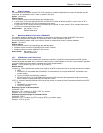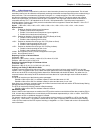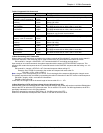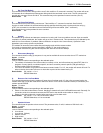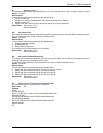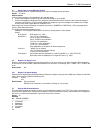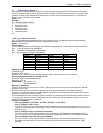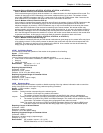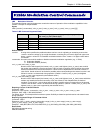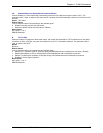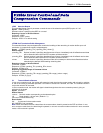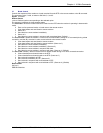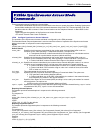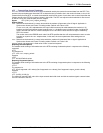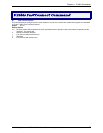
Chapter 4 - V.22bis Commands
Multi-Tech Systems, Inc. MT2456SMI-22 SocketModem Developer’s Guide 26
Extension Pick-up (Enabled by AT-STE=2, AT-STE=3, AT-STE=6, or AT-STE=7):
Case 1: Modem off-hook, Local Handset Goes Off-Hook
If the local handset goes off-hook while the modem is in a data connection, the local handset will be muted. The
modem will then send a GSTN Cleardown to the remote modem and then go on-hook. The modem will then
send a NO CARRIER message to the DTE. A result code of 25 will be left in S86 register. After 2 seconds, the
local handset will be connected to the telephone line so the user hears the dial tone.
Case 2: Modem off-hook, Extension Pick-up
If the modem is connected and another extension goes off-hook, the modem will send a GSTN Cleardown to the
remote modem and then immediately hang-up. Due to the noise possibly being added to the line when a
telephone extension is picked-up, a GSTN Cleardown may or may not successfully be received by the remote
mode. If the GSTN Cleardown is not received successfully by the remote modem, the remote modem may
attempt a retrain until the retrain fails and the remote modem drops the line. In any case, the modem will send a
NO CARRIER message to the DTE immediately after sending the GSTN Cleardown. A result code of 25 will be
left in the S86 register. Because the extension is off-hook, the modem cannot flash the hook for the central office
to generate a dial tone. In this case, the user must flash the extension handset to obtain a dial tone.
Remote Hang-up (enabled by AT-STE=4, AT-STE=5, AT-STE=6, or AT-STE=7):
Case 1: Modem off-hook, Remote Hang-up
If the modem is connected (off-hook) and the remote modem/server goes hangs up, the central office may issue
a line polarity reversal. If a line polarity reversal is detected, the modem will drop the call and respond with NO
CARRIER. The reason for hang-up can be determined by S86=25. A line reversal can also be simulated by
simply pulling out the telephone line during a connection.
+PCW Call Waiting Enable
This command controls the operation of the modem in the presence of call waiting.
Syntax +PCW=<value>
Defined Values
<value> Decimal number corresponding to the selected operation.
0 Collect caller ID information if enabled by +VRID. Toggle V.24 circuit 125. (Default)
1 Hang-up.
2 Ignore call waiting.
Result Codes OK <value> = 0, 1, or 2
ERROR Otherwise
Reporting Selected Value(s)
Command: +PCW?
Response: +PCW: <value>
Example: +PCW: 0 For the default setting.
Reporting Supported Range of Parameter Values
Command: +PCW=?
Response: +PCW: (<value> range)
Example: +PCW: (0,1,2)
+VDR Distinctive Ring
This command causes the modem to enable or disable reporting of the ring cadence information and to control the
timing of the RING event code report if ring cadence reporting is enabled.
Syntax +VDR=<enable>, <report>
Defined Values
<enable> Decimal number corresponding to the selected option.
0 The modem will not report ring cadence information.
1 The modem will report ring cadence information as specified for the <report> subparameter.
<report> Decimal number specifying ring cadence information report when enabled by <enable> subparameter.
0 The modem will produce only DROF and DRON messages. The modem will not produce any RING
event codes. The modem will report other call progress event codes as normal.
Other The modem will produce only DROF and DRON messages. Modem will produce a RING event
code after <report>/10 seconds after the falling edge of the ring pulse (i.e., after DRON report).
Reporting Current or Selected Values
Command: +VDR?
Response: <enable>,<report>
Example: 0,0 For the default setting.
Reporting Supported Range of Parameter Values
Command: +VDR=?
Response: (<enable> range),(<report>range)
Example: (0,1),(0-6)
Result Codes OK <enable>,<report> = (0,1),(0-6)
ERROR Otherwise, or if not in Voice Mode



